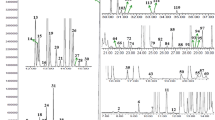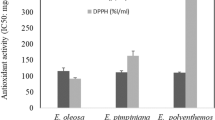Abstract
A phytochemical study of Phlomis thapsoides (Lamiaceae) resulted in the isolation of one new compound, 6,10,17-trimethyl-2-octadecanone, and three known compounds (sitosterol-3-O-β-glucoside, and the iridoid glucosides ipolamiide and lamiide). The structures of the isolated compounds were elucidated using mass spectrometry, 1D/2D NMR spectroscopy experiments in comparison with published data. The chemical composition of the essential oil obtained from aerial parts of P. thapsoides was determined by gas liquid chromatography and gas liquid chromatography-mass spectroscopy. The main volatile constituents were phenylethyl alcohol (6.81 %), trans-3-hexenol (5.55 %), 1-octen-3-ol (5.10 %), α-cadinol (4.92 %), and α-muurolol (4.67 %). The antioxidant activity of the extracts was evaluated by three methods: 1,1-diphenyl-2-picrylhydrazyl free radical scavenging activity, 2,2′-azinobis-[3-ethylbenzthiazoline-6-sulfonic acid] and ferric reducing antioxidant power assay along with the determination of total phenolic content. Although the ethyl acetate extract contained 362.06 mg of gallic acid equivalents, the antioxidant activities, as revealed by 1,1-diphenyl-2-picrylhydrazyl, 2,2′-azinobis-[3-ethylbenzthiazoline-6-sulfonic acid] and ferric reducing antioxidant power assays, were of medium strength (IC50 of 73.08 ± 3.18, 9.48 ± 0.71 µg/mL and 9.33 ± 0.17 mM of FeSO4 equivalents, respectively). Only lamiide inhibited soybean 5-lipoxygenase with an IC50 value of 72.92 µg/mL in vitro. In-silico molecular modeling studies on 5-lipoxygenase and human 5-lipoxygenase-activating protein were used to evaluate the potential anti-inflammatory activity. Sitosterol-3-O-β-glucoside followed by the iridoid glucoside lamiide exhibited the highest inhibition of 5-lipoxygenase whereas the new compound 6,10,17-trimethyl-2-octadecanone and sitosterol-3-O-β-glucoside exhibited the highest inhibition of 5-lipoxygenase-activating protein as evidenced from their higher fitting scores. The cytotoxicity of the plant extracts and lamiide against Caco2 and HepG-2 cancer cells resulted in IC50 values of >100 µg/mL indicating a low cytotoxicity.




Similar content being viewed by others
References
Adams RP (2007) Identification of essential oil components by gas chromatography/quadrupole mass spectroscopy. Allured Pub Corp., Illinois
Amor IL-B, Boubaker J, Sgaier MB, Skandrani I, Bhouri W, Neffati A, Kilani S, Bouhlel I, Ghedira K, Chekir-Ghedira L (2009) Phytochemistry and biological activities of Phlomis species. J Ethnopharmacol 125:183–202
Bader A, Tuccinardi T, Granchi C, Martinelli A, Macchia M, Minutolo F, De Tommasi N, Braca A (2015) Phenylpropanoids and flavonoids from Phlomis kurdica as inhibitors of human lactate dehydrogenase. Phytochemistry 116:262–268
Delaporte RH, Sánchez GM, Cuellar AC, Giuliani A, Palazzo de Mello JC (2002) Anti-inflammatory activity and lipid peroxidation inhibition of iridoid lamiide isolated from Bouchea fluminensis (Vell.) Mold. (Verbenaceae). J Ethnopharmacol 82:127–130
El-Ahmady SH, Ashour ML, Wink M (2013) Chemical composition and anti-inflammatory activity of the essential oils of Psidium guajava fruits and leaves. J Essent Oil Res 25:475–481
Ferguson AD, McKeever BM, Xu S, Wisniewski D, Miller DK, Yamin TT, Spencer RH, Chu L, Ujjainwalla F, Cunningham BR (2007) Crystal structure of inhibitor-bound human 5-lipoxygenase-activating protein. Science 317:510–512
Gürbüz İ, Üstün O, Yesilada E, Sezik E, Kutsal O (2003) Anti-ulcerogenic activity of some plants used as folk remedy in Turkey. J Ethnopharmacol 88:93–97
Hesse M, Meier H, Zeeh B (1997) Spectroscopic methods in organic chemistry. Georg Thieme Verlag Stuttgart, New York
Kyriakopoulou I, Magiatis P, Skaltsounis AL, Aligiannis N, Harvala C (2001) Samioside, a new phenylethanoid glycoside with free-radical scavenging and antimicrobial activities from Phlomis samia. J Nat Prod 64:1095–1097
Kirimer N, Başer KHC, Kürkcüoglu M (2006) Composition of the essential oil of Phlomis nissolii L. J Essent Oil Res 18:600–601
Li MX, Shang XF, Jia ZP, Zhang RX (2010) Phytochemical and biological studies of plants from the genus Phlomis. Chem Biodiver 7:283–301
Lü JM, Nurko J, Weakley SM, Jiang J, Kougias P, Lin PH, Yao Q, Chen C (2010) Molecular mechanisms and clinical applications of nordihydroguaiaretic acid (NDGA) and its derivatives: an update. Med Sci Monit 16:RA93–100
Mabberley DJ (2008) Mabberley’s plant-book: a portable dictionary of the vascular plants. Cambridge University Press, Cambridge
Maksudov MS, Maksimov ES, Umarova RU, Saatov Z, Abdullaev ND (1995) Phlomoside A—an iridoid glycoside from Phlomis thapsoides. Chem Nat Compd 31:200–202
Mamadalieva NZ, Mamedov NA, Craker LE, Tiezzi A (2014) Ethnobotanical uses and cytotoxic activities of native plants from the Lamiaceae family in Uzbekistan. Acta Hortic 1030:61–70
Mamadalieva NZ, Sharopov F, Girault JP, Wink M, Lafont R (2014a) Phytochemical analysis and bioactivity of the aerial parts of Abutilon theophrasti (Malvaceae), a medicinal weed. Nat Prod Res 28:1777–1779
Misra TN, Singh RS, Upadhyay J, Tripathi DM (1984) Aliphatic hydroxy ketones from Curculigo orchioides rhizomes. Phytochemistry 23:1643–1645
Mosmann T (1983) Rapid colorimetric assay for cellular growth and survival: application to proliferation and cytotoxicity assays. J Immunol Methods 65:55–63
Sarkhail P, Abdollahi M, Shafiee A (2003) Antinociceptive effect of Phlomis olivieri Benth., Phlomis anisodonta Boiss. and Phlomis persica Boiss. total extracts. Pharmacol Res 48:263–266
Sarkhail P, Rahmanipour S, Fadyevatan S, Mohammadirad A, Dehghan G, Amin G, Shafiee A, Abdollahi M (2007) Antidiabetic effect of Phlomis anisodonta: effects on hepatic cells lipid peroxidation and antioxidant enzymes in experimental diabetes. Pharmacol Res 56:261–266
Sharopov FS, Wink M, Setzer WN (2015) Antioxidant activities of essential oil components—an experimental and computational investigation. Nat Prod Commun 10:153–156
Swift LJ (1952) Isolation of β-sitosteryl-D-glucoside from the juice of Florida Valencia oranges (Citrus sinensis L.). J Am Chem Soc 74:1099–1100
Tomimatsu T, Hashimoto M (1968) Studies on the chemical components of Rutaceae plants. II. Components of the root of Poncirustri feliata Rafinesque. Yakugaku Zasshi 88:1357–1359
Van Wyk B-E, Wink M (2004) Medicinal plants of the world. Timber Press, Inc., Portland
Vvedenskiy A (1961) Flora of Uzbekistan. (vol 5). Academy of Sciences UzSSR Press, Tashkent
Wink M (2008) Evolutionary advantage and molecular modes of action of multi-component mixtures used in phytomedicine. Curr Drug Metabol 9:996–1009
Wink M (2015) Modes of action of herbal medicines and plant secondary metabolites. Medicines 2:251–286
Yalcin FN, Ersoz T, Avci K, Gotfredsen CH, Jensen SR, Calis I (2007) New iridoid glycosides from Lamium eriocephalum subsp. eriocephalum. Helv Chimica Acta 90:332–336
Yalcin FN, Kaya D, Calis I, Ersoz T, Palaska E (2008) Determination of iridoid glycosides from four Turkish Lamium species by HPLC-ESI/MS. Turk J Chem 32:457–467
Yayli N, Yildirim N, Usta A, Ozkurt S, Akgun V (2003) Chemical constituents of Campanula lactiflora. Turk J Chem 27:749–755
Youssef FS, Hamoud R, Ashour ML, Singab AN, Wink M (2014) Volatile oils from the aerial parts of Eremophila maculata and their antimicrobial activity. Chem Biodiver 11:831–841
Zhang Y, Wang ZZ (2008) Comparative analysis of essential oil components of three Phlomis species in Qinling Mountains of China. J Pharm Biomed Anal 47:213–217
Zhang Y, Wang ZZ (2009) Phenolic composition and antioxidant activities of two Phlomis species: a correlation study. C R Biol 332:816–826
Acknowledgments
The authors would like to thank the DAAD for a scholarship to N.Z. Mamadalieva and the Egyptian government for providing financial support for T. Mohamed. The authors express their special thanks to Dr. M.G. Levkovich, Dr. K. Bobakulov and Mr. T. Timmermann for their help recording NMR spectrum and to Dr. Olim Nigmatullaev for collecting the plant materials. Part of this study was funded through a grant from the Republic of Uzbekistan State Foundation for Basic Research (Grant No. FA-F6-Т-209).
Author information
Authors and Affiliations
Corresponding author
Ethics declarations
Conflict of interest
The authors declare that they have no competing interests.
Electronic Supplementary Material
Rights and permissions
About this article
Cite this article
Sobeh, M., Mamadalieva, N.Z., Mohamed, T. et al. Chemical profiling of Phlomis thapsoides (Lamiaceae) and in vitro testing of its biological activities. Med Chem Res 25, 2304–2315 (2016). https://doi.org/10.1007/s00044-016-1677-9
Received:
Accepted:
Published:
Issue Date:
DOI: https://doi.org/10.1007/s00044-016-1677-9




